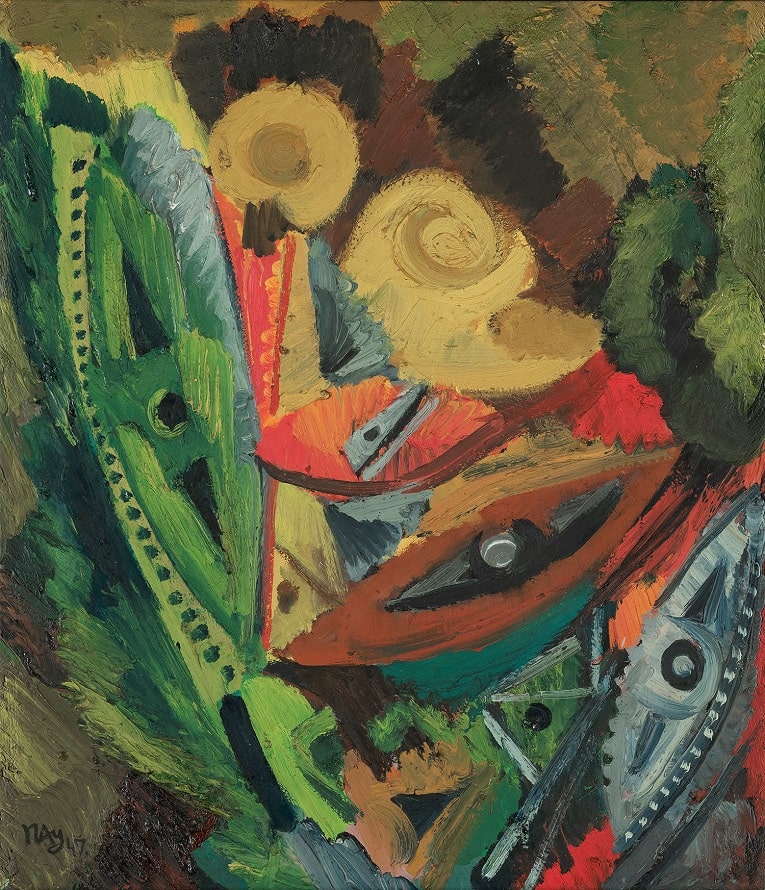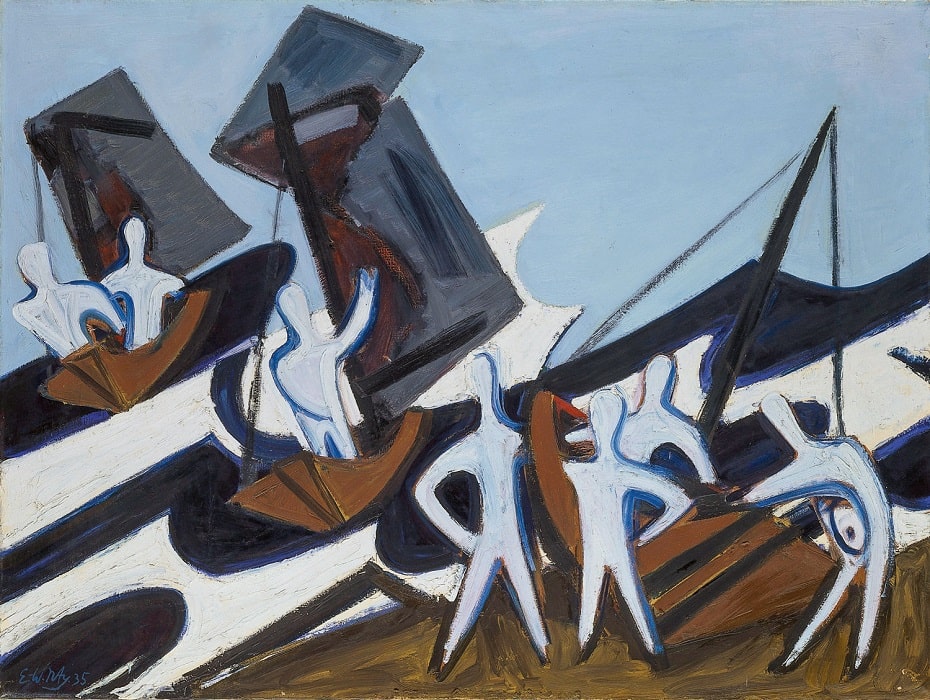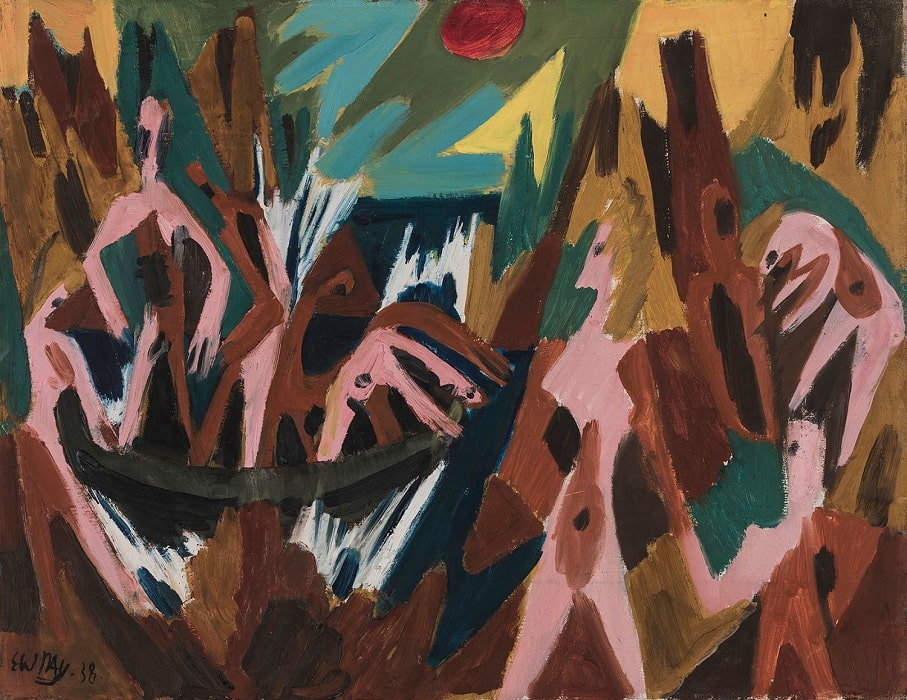Ernst Wilhelm Nay (1902-1968) is one of the most important artists of the second half of the 20th century. His painting is figurative and abstract. Nay’s series of works are versatile, profound and rich in colour: they tell of his engagement with the elemental forces of nature, rhythmic music, antiquity and religion or the natural sciences. The Museum Wiesbaden, which strongly supported Nay after the Second World War, will present the artist in a solo exhibition for the first time in the museum’s history from 16 September 2022 to 5 February 2023.
Fig. above: Ernst Wilhelm Nay, People in the Lofoten Islands, 1938, Museum Wiesbaden, acquired 1958 © VG Bild-Kunst, Bonn 2022
With its almost 100 paintings, the retrospective shows works from all creative phases. Not only the painter’s famous late disc and eye paintings are shown, but also his lesser-known figurative beginnings with his early Lofoten and France paintings. A special focus is on the Hekate and Fugal paintings created in the Rhine-Main region. Nay lived in Hofheim am Taunus between 1945 and 1951.
Ernst Wilhelm Nay (b. Berlin 1902-1968 d. Cologne), after abandoning an apprenticeship in the book trade, entered Karl Hofer’s painting class at the Berlin Hochschule für Bildende Künste, from which he graduated successfully as a scholarship holder in 1928. Nay’s early works were quickly purchased by museums and his first exhibitions were held. Inspired by the fishermen on the Baltic Sea and by two stays on the Lofoten Islands sponsored by Edvard Munch, he produced expressive dune and fishermen’s pictures. At the same time, the National Socialists temporarily ban him from exhibiting his work, and two of his works are shown in the “Degenerate Art” exhibition. Nay’s war service took him to France and after the end of the war, because his studio flat in Berlin had been destroyed, to the Rhine-Main area to Hofheim in the Taunus to live with his friend and patron Hanna Bekker vom Rath. With the works he created here, Nay achieved great success both nationally and internationally – for example, at the first three documenta shows (1955, 1959, 1964) and the Biennales in Venice (1948, 1950) and Sao Paolo (1955). From then on he was perceived at home and abroad as an icon of German art after 1945. With his independent pictorial language, Nay transposed the era of figurative Expressionism of Classical Modernism into the gestural abstraction of the second half of the 20th century. He has gone down in the canon of art history as an intuitive-emotional colour painter who constantly traced the abstract laws behind things in his dense paintings: “Painting is the mental setting of colour – guided and accompanied by a system.” (Ernst Wilhelm Nay, c. 1967)

Nay himself divided his development as a painter into successive work phases. He spoke of the Lofoten (1937/38), the France (1942-44), the Hekate (1945-1948), the Fugal (1949-51), the Rhythmic (1951-53) and the Disc (1954-62), Eye (1963/64) and Late Pictures (1965-68). Major works from all these groups of works are presented in the special exhibition “Ernst Wilhelm Nay – Retrospective”: “The principal chronology of the exhibition is deliberately broken at several points in order to make it clear,” says Dr. Roman Zieglgänsberger, curator of the exhibition, “that the early figurative Nay cannot be separated from the late abstract Nay, that, for example, through pictorial motifs cultivated throughout by the artist, such as butterflies, eyes or stars, the great theme of the painter remains throughout: Locating man and his existence in the eternal flow of world time with his colourful paintings.”
Early promotion by the Museum Wiesbaden:
After the Second World War, it was the Museum Wiesbaden that promoted Nay most strongly in the Rhine-Main region during his Hofheim years. From Hofheim, where the artist lived from 1945 to 1951, he made many trips to the state capital, visited the exhibitions of the Central Collecting Point (in the Museum Wiesbaden) and soon made contact with the local director Clemens Weiler. During his tenure from 1949, the latter not only acquired four paintings (“Leda”, “Pilgrim”, “African” and “People in the Lofoten”), but also the artist’s first colour lithograph portfolio as early as 1951. In gratitude for the many purchases, Nay donated three gouaches to the museum that can be attributed to the Fugalen work phase. One of the twelve rooms in the exhibition is dedicated to Nay’s close relationship with Weiler, which is also reflected in the artist’s correspondence with the museum man. There is another close connection between the artist and the museum through Hanna Bekker vom Rath, who found Nay a studio in Hofheim in the summer of 1945, presented it in her Frankfurt art cabinet in 1949 and whose private collection has been preserved in the Museum Wiesbaden since 1987 (including several Nay works).
“Given the many interrelationships between the artist and our museum, it is surprising that there has never been a solo exhibition on Nay here before,” says museum director Dr Andreas Henning. “All the more reason for us, together with the Hamburger Kunsthalle, the Museum Küppersmühle in Duisburg and the Cologne-based Ernst Wilhelm Nay Foundation, to be able to close this gap in our exhibition history, of which we are very aware, at the very happy moment when we have acquired two important paintings – a Baltic Sea painting and a disc painting – through the Jan and Friederike Baechle Collection.

The exhibition catalogue of the same name (edited by Karin Schick, Sophia Colditz and Roman Zieglgänsberger, Wienand Verlag, ISBN 978-3-86832-646-8, 29,90,- Euro at the museum box office) offers in-depth and further content. Two media tours (for adults and for children and young people) in the free Museum Wiesbaden app accompany the show. Media guides can be used on site for a rental fee of 3 euros.
Wiesbaden is the second stop of the travelling exhibition “Ernst Wilhelm Nay – Retrospective”. Previously, the show was on display at the Hamburger Kunsthalle, after which it will go to the Museum Küppersmühle für Moderne Kunst in Duisburg.
WHERE?
Museum Wiesbaden
Friedrich-Ebert-Allee 2
65185 Wiesbaden
WHEN?
Friday, 16. September 2022 bis Sunday, 5. February 2023






